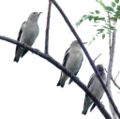| Agropsar | |
|---|---|
 | |
| Daurian starling (Agropsar sturninus) | |
| Scientific classification | |
| Kingdom: | Animalia |
| Phylum: | Chordata |
| Class: | Aves |
| Order: | Passeriformes |
| Family: | Sturnidae |
| Genus: | Agropsar Oates, 1889 |
Agropsar is a genus of Asian birds in the family Sturnidae. It is sometimes merged with Sturnus or Sturnia
These two species were formerly placed in the genus Sturnus . They were moved to the resurrected genus Agropsar based on the results of two molecular phylogenetic studies published in 2008. [1] [2] [3]

